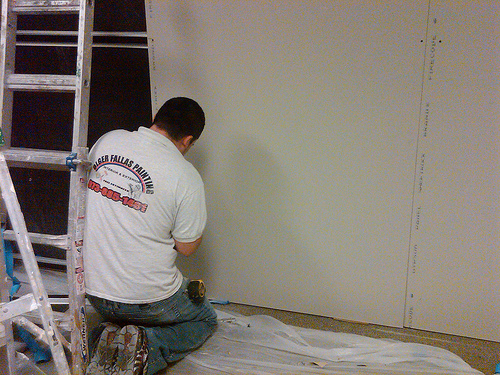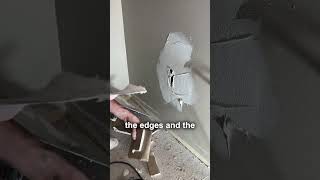[post_name drywall patch Is It Time To Do Some Repair Work On Your Drywall?

Do it on your own drywall setup is just one of the more practical works you can take on as a home owner. Whether you have actually obtained a ceiling that's been damaged by a leaking roof or air conditioner frying pan, or some brand-new wall surfaces that become part of a redesigning task, at some factor, you'll require drywall service your house. The great thing is; with the right understanding, the proper devices, and also some method; almost any person can do it. The fundamental thing you have to recognize consist of:
Products-This may appear very obvious, however there are a few various alternatives.
- Thickness-Drywall or sheetrock is available in 1/4", 1/2", and also 5/8" thicknesses. The most usual in household is 1/2". 5/8" is much more generally made use of in industrial job as well as is a need of building regulations in many areas due to it's higher fire resistant ranking. 1/4" is primarily used over other products such as paneling or plaster when a different kind of wall surface area is wanted. If you're doing a spot or repair service; check the density of the existing drywall prior to getting your brand-new product to guarantee that it matches.
- Application-The majority of wall surfaces and also ceilings will certainly have basic grey sheetrock. Nevertheless, in high wetness locations, such as shower rooms and kitchens; make use of the much more water resistant environment-friendly rock. There is likewise, currently, a drywall that contains the same kind of cement fiber products used in ceramic tile backer boards for use on wall surfaces that will do with floor tile.
- Joint Substance-Additionally called sheetrock mud, this is the crucial element to a successful do it on your own drywall setup. This will be available in pre-mixed paste like type in boxes or buckets or powdered, in bags, that need to be blended with water. There are likewise rapid drying kwikset products that could be used for patches and fixings.
- Joint Tape-This could be purchased in the standard paper kind, which should be applied with joint substance or in fiber tape, which is typically used in repair services because it eliminates one step of the process.
- Nails or Screws-Generally, nails have actually been used in property work and also screws in industrial (as a result of making use of steel studs. Nevertheless, screws have ended up being extra in property because of the speed of screw guns.
- Drywall Knives-These kinds of knives are not used for cutting, however for spreading out the mud, taping the joints, and also drifting and skimming; and also, in fact appear like a spatula greater than a knife. They come in a range of widths from regarding 3" (made use of for taping seams) as much as 12" (for drifting as well as skimming). You will, more than likely, require at the very least 3 dimensions for any kind of work, as each skim coat gets a little wider.
- Mud Frying pan-These lengthy rectangular pans come in metal or plastic as well as are used for holding the joint compound. They're slim adequate to accept one hand, while utilizing the blade with the various other.
- Energy Knife/Sheetrock Saw-A lot of the cutting of sheetrock is currently maded with energy knives with interchangeable blades. Modification them as often as required for a clean very easy cut. Sheetrock saws are long (about 10") triangular saws with small deals with as well as are used mainly for cutting holes for plumbing and electrical.
- High Powered Drill & & Paddle Little bit-If you're doing a little fixing; you could blend the mud manually with a drywall blade. But also for bigger do it on your own drywall installation tasks, it's crucial that you have a solid adequate drill to mix the mud with a paddle for the correct uniformity and to get rid of lumps.
- Safeguard it Excellent-Do not stint nails or screws. You don't desire activity when a person leans versus the wall surface. Cannot effectively fasten it will result in cracks in the mud.
- Expect Intermediaries-Maintain a close eye on switches, plugs, and also phone jacks. They're very easy to hide as well as challenging to locate later.
- Have Enough Assist-Sheetrock weighes. Make certain you have somebody in order to help you hold it while you get the screws or nails in. This is specifically real when hanging ceilings.
- Countersink the Fasteners-Make certain the nails or screws permeate beyond the surface so that they could be covered with mud.
- Tape the Seams-This can be maded with either the paper or fiber tape. With paper, spread a slim coat of mud over the joint, the, using a drywall blade; press the tape into the mud and also over the joint. Then utilize the blade to eliminate the excess mud. When this process is completed; you need to wait on the mud to dry before using the very first skim layer. The advantage of the fiber tape is; it sticks to the sheetrock without the need for mud. So, you could quickly apply a skim layer.
- Drift as well as Skim-This may be carried out in one layer or it might take 2 or 3. The concept is to have an also surface area without rises, bumps, as well as dips. Among the tricks to an effective do it on your own drywall installment is mixing the mud to the appropriate consistency so it spreads out quickly. The other is just excellent old fashioned method. Some people require to it quicker than others. But, the extra you do it, the much better you'll be.
How to Remove Drywall Texture
For small burrow to around & frac12;" you can simply use spackling compound as well as a putty knife. Apply the spackle, wait until it dries then sand smooth. Spackling substance will certainly reduce a little bit so sometimes you will require to apply a second coat after the initial layer dries, you will then should sand it once again prior to repairing the paint.For tool
openings 1/2" to 3" you will certainly should obtain a drywall spot (there are various other techniques to repair an opening this dimension yet a drywall spot set is the most basic). Most of these packages feature a patch that is self adhesive. Simply cut the patch so that it is larger than the dimension of the opening by regarding 1" as well as stick it over the opening (some packages actually enable you to stick the spot via the opening then draw it limited behind the back of the opening enabling you to fill out just the opening).
Then you will certainly require drywall substance (which can be found in smaller sized containers compared to a gallon) or spackling substance. Utilizing a large blade putty blade (3" or broader), apply the substance over the spot and a couple of inches bordering the opening, then after it dries out, sand it smooth. You will certainly should duplicate this step a number of times till you can no much longer see where the patch is, fining sand after each coat dries out. Ultimately, retouch the paint.For bigger
holes 3" and larger it is commonly best to replace a section of the drywall. Find where the closest stud is, after that removed a rectangle around the hole including half of the width of the stud. After that, using the removed item as a layout reduced a fresh item of drywall to fit the opening. Place the drywall in the red as well as use drywall screws to attach it to the stud. (It is also better if you eliminated an item that is huge sufficient to subject fifty percent of two studs to ensure that the drywall is also firmer in position. Studs are usually placed 18" apart however can be anywhere between 12" to 24" apart.)
Utilizing you "mudding blade" (or huge putty knife), use a slim layer of drywall mud to cover the whole joint. Next off, use paper drywall tape over the mud and also using your blade, embed the paper strongly into the mud, removing any kind of excess mud. Hereafter dries out apply an additional 2 to 3 coats of drywall mud over the joint tape prolonging approximately 6" on either side of the joint, fining sand between each layer. Once the repair service job is smooth you can repair the paint.

Is It Time To Do Some Repair Work On Your Drywall?
Drywall repair Altamonte Springs - drywall prices
